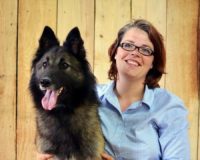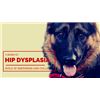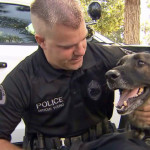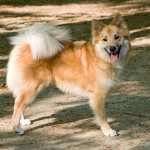Herding Terminology: Do You Know the Basics?
Herd Herd Herd… Herd is the Word
Oh the herding lingo. Every sport from volleyball to racing has its terminology, and it can be quite overwhelming initially. Herding is no different - the sport is full of fun and interesting words! Sometimes the words make sense and are descriptive, but sometimes not so much. What does it mean when they say the dog is fetching sheep or driving cattle? Come bye and away to me…what do THOSE mean? Is “that’ll do” a REAL herding command?
If you are interested in trying herding with your dog, you may find knowing a bit about the terms used in herding helpful as you begin. Perhaps you are just going to watch a competition and are interested in knowing a bit about what is going on out there on the field.
Here are some basic herding words and what they mean:
Stock - The animals (of any species) that the dog is working. These can be cattle, sheep, goats, ducks, geese, and even turkeys. All commonly present on the farms of yesteryear, each needing chores and management - and the herding dog helps make that happen!
Draw - Where the stock wants to be. They go to their fellow animals, to food, or to find a way out of the pen they are in. It’s like the “stock magnet” in the space you are in. The herding dog must read this body language and cover it.
Cover - What the herding dog does (without direction) to counter the draw. If the sheep are running for a gate and you want to bring them to the opposite side of the barnyard, the herding dog must “cover the draw” to make the sheep move the way the handler wants. Sometimes this puts the dog in an odd place on the field, but if the stock are moving the direction that is desired, it is considered correct and the dog is said to be "covering the draw".
Bubble - The personal space or flight bubble of the stock. It surrounds every group of animals like an imaginary force-field bubble. Each group of animals may have a different size bubble depending on their nature. If they are jumpy, it may be a big, sensitive bubble and the dog must work farther out. If they are stable (heavy), it may be a small bubble and the dog can get closer. This can be a “formula” between the stock and the dog, and may change with the dog, the day, and the input or removal of certain individuals in the stock group.
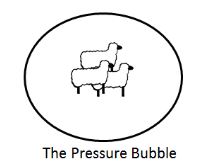
Balance (Balance Point or In Balance) - The point on the stock’s bubble that the dog must be AT to get the stock to move in the direction and at the pace desired. This can be a very specific spot.
Pressure - Because there are three entities out on the farm yard/field, there are three types of pressure interactions going on at the same time:
1) The dog’s pressure on the stock. A dog puts pressure on stock with their eye, their movement and their intent/power.
2) The handler to the dog. The handler can apply pressure on a dog by using intent, voice, blocking/taking away a path to the stock. This can be used to train the dog or to help move stock.
3) The stock or a fence to the dog. The dog may feel pressure by the tight space between the stock and a corner or when the stock stares, stomps or charges the dog.
Heavy Stock - Doesn’t refer to the physique of the animals, but rather to their willingness to stay with the human in the pen or on the field. Heavy stock are sometimes known as “knee knockers” because they stick so close to the handler they seem to always be in the way of the handler trying to walk.
Light Stock - The opposite of heavy stock. Light stock doesn’t want to be near the dog (of course), but doesn’t want to be with the handler either. They are sensitive to pressure on their bubble and can be fun, but sometimes frustrating to work with. They can bolt, run, and dart away when the dog puts too much pressure on them or if the dog is not correct on the balance point.
Fetch - Bring stock to the handler. The dog must get around the stock and to the backside of the stock bubble to apply pressure to the balance point, which brings the stock in directly to the handler. Ideally the dog brings the stock directly to the handler at a nice, controlled (slow) pace.
Fetching - The handler starts walking and the dog keeps the stock with the handler.
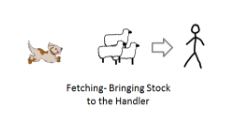
Drive - Take stock to a point that is NOT the handler. Driving is using the dog to move the stock to a gate, trailer, or other point that may not be anywhere near the handler. The dog moves along the bubble to a balance point that gets the stock to move in the direction desired. The dog may be taking the stock away from the handler or parallel with the handler. You can see if the dog is directly behind the sheep, they would walk in a straight line. If you wanted to move the sheep slightly to the left or to the right, you would need the dog to move on the pressure bubble to change the stock’s direction. These directions are called flanks.

Flank - The movement of the dog on the stocks pressure bubble where the dog is moving around the outside but the stock is not moving. Think of it kinda like circling the stock and getting to a different point on the circle. Flanking is a dog positioning tool intended to move the dog around the stock bubble so the balance point (and then the stock) direction will change.
Go Bye (Come Bye) - Flank command/direction used in driving. Dog moves clockwise on the stocks’ bubble. If the stock was the center of a clock face, the dog would be moving around the outside of the clock, clockwise. Go-ing By- the way of the clock.

Away to Me - Flank command/direction used in driving. Dog moves counterclockwise on the stocks’ bubble. If the stock was the center of a clock face, the dog would be moving around the outside of the clock, counterclockwise. Away from the way of the clock. A=anticlockwise.
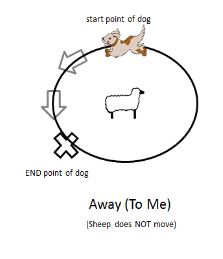
That’ll Do - Your job is done. Stop what you are doing, no more working stock. The conclusion to a herding session.
You can even start practicing these commands at home with your pup before your first herding lesson - no sheep necessary! Readers who live in cities have mentioned they found areas and off-leash dog parks where they can practice with geese and ducks, for example. You can also check out our article on Treibball called No Sheep, No Ducks, No Problem!
Until then ... that’ll do!
Article By:
Eva Raczka
Meet Our Evangelist
